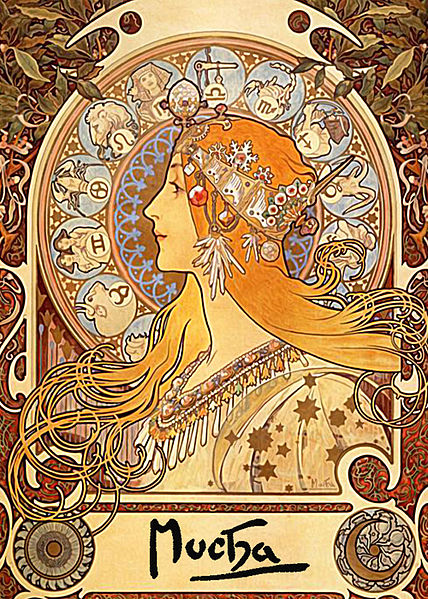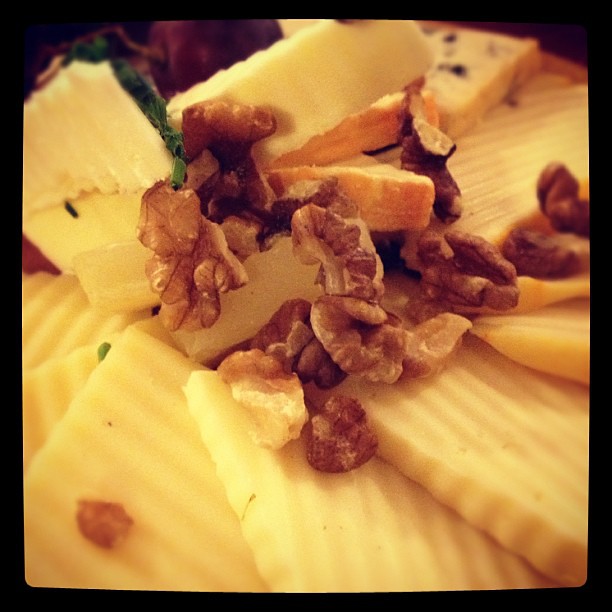Like many other large and picturesque cities, Prague offers horse-drawn carriage tours; for those who want to move at a more modern pace, you can also indulge in an antique car tour. Or, if you are hard-core and want to earn that indulgent meal for which you've made reservations at the end of the day, you can walk. I bet you can guess which of these three options my parents and I chose for their second, and my third, day in Prague.
(Nope, not this one. I just took a photo because I liked the horses' ear-warmers, or whatever those are.)
Yes, that's right, even after the previous evening's seemingly endless trek in search of the elusive Cubist lamppost, we hadn't yet reached our fill of walking. The best part about hoofing it on this particular day was that we were planning to see the castle, cathedral, and monastery--all of which were at the top of a giant hill up which I had already huffed and puffed on my first day touring the city. I was pretty excited for Round 2
In all seriousness, though, the hill wasn't too bad. First, the weather had changed dramatically overnight, and autumn had fully arrived. Even in direct sunlight, it was much cooler than on the previous couple of days. Second, the Old Castle Steps are pretty broad, and the slope is surprisingly mellow; you are definitely walking up a hill, but you're also definitely not climbing up a mountain. Third, the walk offers plenty of lovely sights and sounds to distract you, from buskers playing accordions and guitars along the route, to impressive views of the city from a variety of vantage points.
(We passed this statue in a small garden on our way to the Steps.)
(This is your reward for reaching the top of the staircase. Spires!)
(One of the guards outside the entrance to the Prague Castle grounds. I saw him yawn at least four times in the few minutes that we were standing nearby.)
This is the same part of the city where I had spent my first day in Prague, only I had admired the views from outside rather than purchase tickets to go in anywhere. My parents and I splurged on the admission fee so that we could see the most exciting destinations on the hilltop: Golden Lane, the Prague Castle courtyards, St. Vitus Cathedral, the Old Royal Palace, and the Basilica of St. George. You can do this in any order, but because of where we happened to purchase our tickets and enter, we started off with the Golden Lane--which the Lonely Planet guide disparagingly describes as a tourist trap.

That is probably not inaccurate, given that all the little buildings contain shops. However, this is one of the few sections of the castle grounds where you really get a sense of what it would have been like to live inside the castle back when it was relatively new. The cottages along the Lane were built in the 16th century for sharpshooters in the castle guard, but were later used by smiths. Even with all the tourists in the way, it is not hard to visualize what this area would have been like several hundred years ago; it's like what you've seen in movies, only
real.
Also real, unfortunately, were the devices, holding cells, and dungeons used for prisoners. Pretty much the only good thing you could say about the prison facilities was that, subterranean and thick-walled as they were, they were probably less drafty than the rest of the castle.
From the dungeons, we moved on to St. Vitus Cathedral, which, thankfully, was no longer surrounded by a huge group of people waiting to get in--which is one reason why it's a good idea to go sightseeing early on a chilly, Monday morning in October. The exterior of the cathedral is decorated with lots of fantastic gargoyles, but unfortunately my photography skills were lacking, and none of my close-up portraits turned out very well; you'll just have to take my word for it: They were neat.

"Neat" would be an understatement for describing the rest of the cathedral. Like most cathedrals, it was full of all sorts of stuff to compete for your attention--stained glass, gilt, carvings, reliefs, huge altars, tombs, and so on. With all that going on, you'd think it might be hard to concentrate on God, but that is clearly not what Christian interior decorators thought when they decked out all these European churches. One of the notable features of the cathedral was a large stained glass window by Alfons Mucha, who also played an important role in our itinerary later in the day.
Also impressive was the over-the-top baroque tomb of St. John of Nepomuk (him again!). While the tomb was a bit too ornate for my tastes, I couldn't help but admire the level of detail of all its bits and pieces. In the photo above, for example, you really get a sense of the texture of the footwear, and the feet even have toenails and dimples--pretty realistic for a metal sculpture.
I also liked all the faux wooden branches (actually chiseled out of stone) on, under, and around the late-Gothic Royal Oratory on the south side of the cathedral.
Back outside, we wandered around the Cathedral and saw many features that I had missed during my previous visit. These included some ornate gilt windows, mosaics of Adam and Eve, and metal sculptures showing the signs of the zodiac and vignettes of people doing associated, seasonally-appropriate activities:
(Gilt windows)
(Adam and Eve, about to do something very naughty)
(The Aries section of the zodiac panel, with peasants doing something to a young tree--pruning? coppicing? grafting?)
The south side of the cathedral also had a great sculpture of St. George slaying the dragon, but unfortunately the lighting wasn't doing the statue any favors; the day was very overcast and I couldn't find any angles that showed the definition of either George's or the dragon's face. That's another thing you'll just have to imagine for yourselves.
We made our way to the eastern side of the courtyard, and the entrance to the Old Palace. I have previously been to a number of palaces and castles, and generally I am pretty unimpressed because I don't like opulence (palaces) or military stuff (castles). The Old Palace was interesting because it had the feel of a building that was half palace and half castle, and was clearly very grand without being too extravagant. It is, indeed, quite old--bits of it dating to 1135--and I think that's why I liked it; the main hall (Vladislav) had quite an organic, Nordic kind of feel.
No palace would be complete without being associated with
some sort of excess, and in this case the hallway was once used for indoor jousting tournaments; the east end of the room contains a massive door through which riders could enter while already seated on their horses. Ridiculous.
Most of the rooms had one of these, which I at first interpreted as either a decoration (a really,
really big urn of some sort) or some sort of ceramic storage unit. Thankfully, before I could open my mouth and make a fool of myself, my mother commented on the impressive ovens (for heating the rooms, not for baking), and in so doing, she both educated me and saved my pride.
The southwestern portion of the palace contains the office from which Protestant rebels threw two of the Habsburg emperor's advisers in 1618 (an event known as the Second Defenestration of Prague; yes, other people had already been thrown out the windows before--it's a Czech thing). Luckily for them--or, perhaps, unluckily, depending on how squeamish they were--they were spared from death because the moat in which they landed was so full of, um,
sewage.
Upstairs is the New Land Rolls Room, where the clerks' coats of arms cover the walls and ceiling. The offices up here are linked, via a small passageway, to the Diet, or Assembly Hall, on the first floor; back when the palace was still in use, this allowed people to run and grab literature from the library whenever they wanted to check facts during discussions and debates.
Just outside the Old Palace exit is the Basilica of St. George, which was our next destination. The church was originally founded in the early 11th century, and is considered to be the best-preserved Romanesque church in the country. Its exterior and interior have very little in common, since the outer portion is early baroque (i.e. fancy and ~17th-century), while the interior is still Romanesque (i.e. austere and featuring frescoes dating to the 12th century).
Although you could not enter the basilica's crypt, you could peer in through the bars of a grate. I found a familiar face down there:
(Mr. Skeleton--again!)
Our Castle tickets having been well and truly utilized, we exited through the first courtyard just in time to see yet another changing of the guard (my third of the trip) and then made our way past all the lovely sgraffito of Hradcany Square to the Strahov Monastery. Although it was right in the middle of the day, we had no trouble getting ourselves a seat at the St. Norbert restaurant, which my mother had selected because she thought my father might want to try some of their renowned brews. In fact, she even went so far as to (unusually) try her own wee stein of beer:
Since we had reservations for dinner in one of the nicest restaurants in town, none of us wanted to get too full at lunch. So, we mostly just nibbled on appetizer-type food, such as my cheese platter, below:
On all the menus in town, I noticed that walnuts came standard with cheese platters. I found this a bit unusual, since normally I associate cheese with fruit rather than nuts. This platter also contained a strange-looking type of pickle, which I nudged off to the side of the plate. My mother, however, bravely tried it out, and soon pronounced that it tasted the way a horse smells. I'm thinking I dodged a bullet there.
After lunch, my parents walked across the courtyard to see the library and the miniature museum, both of which I had already visited during my first day in town. I had a cup of tea while I waited, and I had barely finished drinking it before they were back again--both of those attractions are definitely worth the entrance fee, but it doesn't take long to go through them.
By that point in the day, we'd pretty much finished with the major points of interest (for us, anyway) on the west side of the river, and so we made our way back down in the hill in order to head back over Charles Bridge and consider our options for the rest of the afternoon. Along the way, we made a few quick stops in order to check off some other things from our tourism to-do list:
(Take a photo of human face-shaped parking meters: Check.)
(Visit the John Lennon wall and photograph Dad in front of "Fred" graffiti: Check.)
(Visit a spot where hundreds of lovers have shown their commitment by putting locks on the bridge and then throwing away the key: Check. Finally have someone explain to me why there are so many random locks in Prague: Check.)
(See the Infant Jesus of Prague statue in the Our Lady of Victory church: Check. One thing I can't check off my list, though, is understanding how on earth any adult could consider, with a straight face, the prospect of collecting intricate outfits for a statue, and changing said statue's clothes as part of a religious ritual. It's like those strange stone geese in the American Midwest, only weirder--because people take it so seriously.)
After navigating Charles Bridge once again, our trio split up: My father went back to the hotel for some more recuperative sleep, and my mother and I went to the
Alfons Mucha Museum near Wenceslas Square. Until my mother expressed a desire to visit the museum, I had no idea who Mucha was; however, I recognized his artwork immediately. If I told you to picture Art Nouveau in your mind, chances are pretty good that you'd visualize something by Mucha. He was incredibly prolific and, because many of his pieces were used in advertising, his artwork is also incredibly familiar to many of us. I couldn't take any photographs in the gallery, but here's a taste courtesy of Wikimedia:

Even though I'd never heard of Mucha prior to that morning, visiting his museum turned out to be my favorite activity of the day. Walking back out into the cold after a cozy hour inside the museum, however, was not very pleasant. In fact, it was so unpleasant that we decided to call a taxi to drive us to our dinner reservation that evening at
V Zatisi. The restaurant wasn't actually that far away--one of the reasons I'd selected it was that it was both good
and fairly close to our lodgings--but, given that my mother and I were wearing fancy shoes and that the temperatures had plummeted, it was a bit too far to walk.
It turned out that the "taxi" ordered by the front desk was actually more of a "hired car," and was about as close as I've ever been to riding in a limousine. The journey was...interesting, and took at least twice as long as it should have. That's because Prague is a city full of one-way streets, and so you often have to go waaaay out of your way in order double back on a cross street and get yourself pointed in the right direction. On top of this, there was construction everywhere, and our driver kept wanting to go down roads that were blocked off for resurfacing. Eventually, after much detouring and many sickening turns, we found ourselves at our destination.
(V Zatisi, as seen on the previous evening. If you look closely, you'll notice a bunch of grapes hanging over the doorway--that's because the restaurant is known for its wines.)
I won't bore you with an endless description of our food, but suffice it to say that it was excellent. Unfortunately, my stomach was acting up a bit that day, plus my appetizer (a duo of goat cheese) was unexpectedly weighty, and so I could only pick at my main course. That was a real shame because it was delicious--crispy duck, two types of cabbage, and Czech "dumplings" (akin to American stuffing). Luckily, my dad pitched in and helped me clean up my plate a bit, so hopefully I didn't leave the staff thinking their food was sub-par. Speaking of the staff, we were surprised to have very attentive service, unlike in the other restaurants where we'd eaten up to that point.

Fortified by our repast, we decided to brave the cold and walk back to our hotel rather than calling for a taxi. It was not easy--cobbled streets are difficult to navigate in dress shoes!--but it was a very pretty walk. Our path took us back through the Old Town Square, where we could see the churches and other historical buildings glowing against the dark night sky. It was impressive.
(This is one of the reasons I love Europe so much.)
Luckily, there were plenty of rambunctious revelers on hand to keep us from becoming too serious and contemplative in the face of all that architectural drama. We made our way through the still-busy streets and treated ourselves to a nightcap in the hotel bar before finally heading upstairs for some much-deserved sleep.




















































